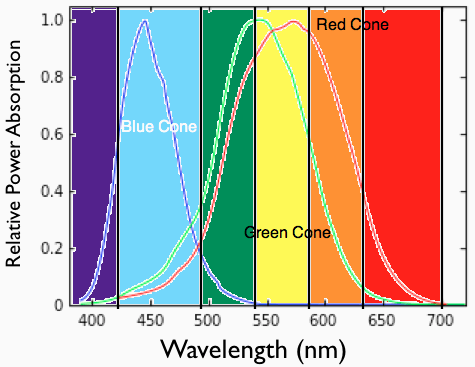Sunlight and the Human Eye
|
|
We continue on our quest of understanding Why Is The Sky Blue? We've learned white light is the sum of all colors of light, the sunlight hits the atmosphere's molecules, which causes the electrons to move like electric current, and molecules excited in this manner will radiate best at higher frequencies. On this page, we will learn Why is the Sky Not Violet?
SunlightWe have discussed how sunlight is made up of all the colors of the rainbow. However, the exact amount of light at each frequency can be measured, and the plot is known as the Solar Irradiance Spectrum, which is shown in Figure 1:
Figure 1. The Solar Spectrum - The Peak Energy is At the Blue Wavelength. The yellow curve in Figure 1 shows the spectrum of light versus wavelength (the inverse of frequency) at the atmosphere (i.e. in the sky). As you can see, the amount of energy is peak in the blue wavelengths, and drops dramatically for purple frequencies (and smaller wavelengths). The red curve shows what the sunlight spectrum is at Sea Level (after atmosphere absorption). Note that the gaps are due to absorption by different molecules within the atmosphere. This partly explains why the sky is blue, and not purple. However, there is another effect which has to do with the human eye. The Human EyeThe human eye has 3 types of receptors known as cones. These cones are microsocopic structures within the eye responsible for observing blue, red and green light. The human eye has millions of cones for detecting light. If you see purple, then your red and blue cones are excited equally (and the green cone not very well). To see yellow, the green cone is stimulated a bit more than the red cone. For a human to perceive a white color, this means all the cones are stimulated. Let's look at the sensitivity of the 3 cones to light versus frequency. This is shown in Figure 2:
Figure 2. Sensitivity of Human Eye Cones. Figure 2 shows how your 3 cones perceive color. The blue curve shows the response versus wavelength for your blue cone. The green curve shows the response for your green cone, and the red curve is the response for your red cone. The important thing is the blue curve in Figure 2. The blue curve is most sensitive at blue wavelengths, and drops off dramatically for the higher frequency (lower wavelength) violet light. Hence, the human eye itself has a natural sensitivity or preference for blue light as opposed to purple light. Therefore, the two primary reasons we see the sky as blue and not purple is because: I think we did it! If we are there we now know why the sky is not black, why it is not purple, and why it is not red. The sky is blue! SummaryThe sky is blue is due to the following facts:  ). This means the molecules
reradiate more energy at higher frequencies (i.e. a blue shift) ). This means the molecules
reradiate more energy at higher frequencies (i.e. a blue shift)
If you made it this far, congratulations! Feel free to drop feedback to me at pjbevel@gmail.com
These notes on sunlight spectrum and the human eye as relates to why is the sky not violet
copyrighted, but can be reproduced without permission as long as the source is referenced.
Copyright antenna-theory.com, 2013-2021.
|
1. Why Is The Sky Blue?
2. White Light 4. Antennas |

